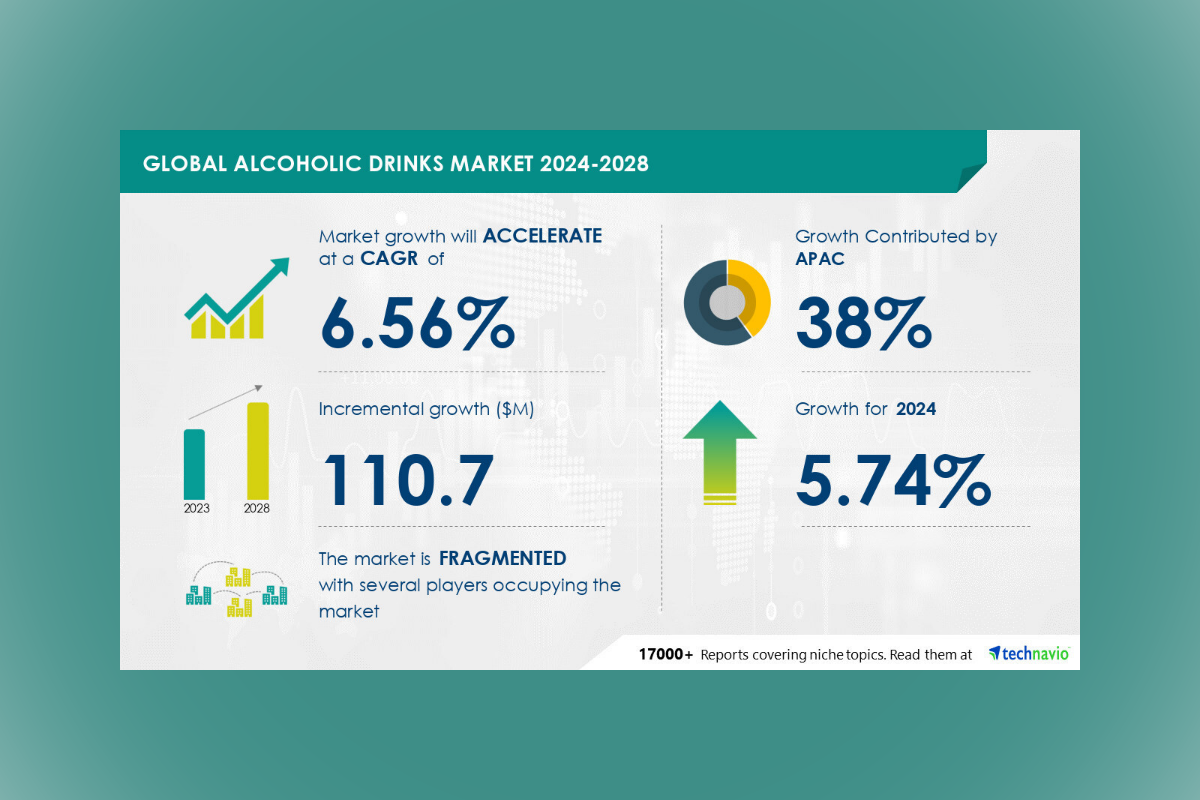
The global alcoholic drinks market size is estimated to grow by USD 110.7 million from 2024-2028, according to Technavio. The market is estimated to grow at a CAGR of almost 6.56% during the forecast period. Increase in popularity of craft segment is driving market growth, with a trend towards increasing consumption of alcoholic drinks. However, prominence of counterfeit products poses a challenge. Key market players include Aceo Ltd., Allied Blenders and Distillers Pvt. Ltd., Anheuser Busch InBev SA NV, Anora Group Plc, Bacardi Ltd., Bronco Wine Co., Brown Forman Corp., Carlsberg Breweries AS, Concha y Toro, Constellation Brands Inc., Diageo Plc, E. and J. Gallo Winery, Heineken NV, Molson Coors Beverage Co., Pernod Ricard SA, Suntory Holdings Ltd., The Boston Beer Co. Inc., The Edrington Group Ltd., The Wine Group LLC, and Treasury Wine Estates Ltd..
Get a detailed analysis on regions, market segments, customer landscape, and companies — Click for the snapshot of this report
Key Market Trends Fueling Growth
In developing economies like India, China, Indonesia, and Singapore, the alcoholic drinks market is experiencing significant growth. This expansion is driven by the increasing demand for premium alcoholic beverages. Producers are expanding their distribution channels, including online stores and convenience stores, to meet this rising demand. New product launches and technological advancements are further fueling industry growth. Prominent players in the market are implementing these strategies, which is anticipated to boost market growth throughout the forecast period.
The alcoholic drinks market is currently experiencing significant growth, particularly in the premium and super-premium segments. Alcoholic beverages such as spirits, wines, and beers are in high demand. Brands like Champagne, Scotch, and Tequila are leading the trend. The market is also witnessing an increase in the number of consumers in developing countries. The digital age has brought about a shift in consumer behavior, with online sales and social media marketing becoming essential. The market is also witnessing a rise in the number of microbreweries and craft beer brands. The health-conscious consumer trend is driving the demand for low and no-alcoholic beverages. The market is expected to continue growing, with innovations in flavors and packaging being key drivers.
Market Challenges
- The alcoholic drinks industry faces a significant challenge from the increasing market for counterfeit alcoholic beverages. These products, made from unauthorized raw materials, pose health risks to consumers and result in substantial revenue losses for manufacturers worldwide. Counterfeit alcoholic beverages, also known as unrecorded or non-commercial drinks, harm brand reputation and sales. Vodka is a common target for counterfeiting. In China, the illegal sale of homemade rice wines is hindering the growth of the authentic wine market, while old and used wine bottles are being bought for fraudulent purposes. To mitigate the impact of counterfeit alcoholic beverages on the market, it is crucial to take robust measures against their production and distribution.
- The alcoholic drinks market faces several challenges in the modern business environment. Premises, such as stores and bars, require licenses to sell these products. Consumption of alcoholic beverages, particularly spirits like whiskey and brandy, can lead to health concerns. Premium brands and craft beers are popular, but their production costs are high. On-premise businesses, like hotels and restaurants, face competition from off-premise sales, such as convenience stores and supermarkets. Alcoholic drinks also face regulatory challenges, with stricter trade regulations and increasing taxes. Additionally, consumer preferences are shifting towards low and no-alcohol beverages. Brands must innovate to cater to these changing trends while maintaining profitability.
Research Analysis
The alcoholic drinks market encompasses a wide range of beverages, including wine, spirits, unflavored and flavored varieties, premium offerings, and craft beers. These beverages are available in various packaging options such as plastic bottles, glass bottles, tins, and more. The market caters to diverse consumer preferences and occasions, with convenience stores, specialty stores, online retailers, hotels, and other establishments like bars and lounges serving as key distribution channels. Alcoholic beverages find extensive use in socializing, urbanization, night parties, and various other settings. Product varieties span from mild-lager beers to microbreweries, brewpubs, restaurants, and wineries. Premium alcoholic beverages and super-premium offerings continue to gain popularity, with whiskey, gin, vodka, flavored wine, and cocktails being popular choices. Brewers and wineries play a crucial role in the production and innovation of these beverages.
Market Research Overview
The alcoholic drinks market encompasses a wide range of beverage categories, including spirits, wines, unflavored beers, flavored beers, and non-alcoholic beverages. These beverages are produced through various processes such as fermentation and distillation. The market is driven by factors such as changing consumer preferences, increasing disposable income, and the growing popularity of premium and super-premium brands. Consumers are increasingly seeking out new and innovative flavors, as well as sustainable and organic options. The market is also influenced by regulatory trends, such as stricter alcohol content regulations and increasing taxes on alcoholic beverages. Overall, the alcoholic drinks market is a dynamic and evolving industry that continues to adapt to changing consumer demands and regulatory environments.
SOURCE: PR News / Technavio (Press Release)
PHOTO CREDIT: Technavio
